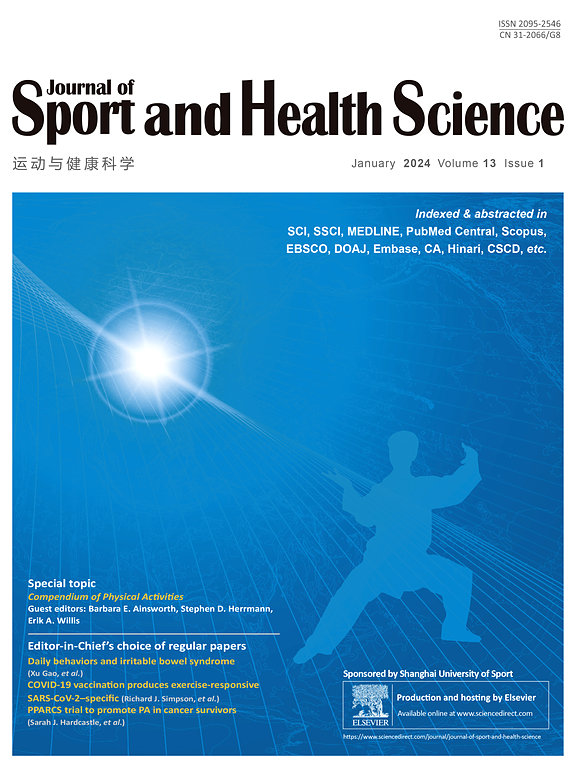Arrhythmias and structural remodeling in lifelong and retired master endurance athletes.
IF 10.3
1区 医学
Q1 HOSPITALITY, LEISURE, SPORT & TOURISM
引用次数: 0
Abstract
BACKGROUND A greater prevalence of arrhythmias has been described in endurance athletes, but it remains unclear whether this risk persists after detraining. We aimed to evaluate the prevalence of arrhythmias and their relationship with cardiac remodeling in lifelong and retired master endurance athletes compared to non-athletic controls. METHODS We performed a cross-sectional analysis of observational studies that used echocardiography and cardiac magnetic resonance to detail cardiac structure and function, and Holter monitors to identify atrial and ventricular arrhythmias in 185 endurance athletes and 81 non-athletic controls aged ≥ 40 years. Athletes were categorised as active lifelong (n = 144) or retired (n = 41) based on hours per week of high-intensity endurance exercise within 5 years of enrollment and validated by percentage of predicted maximal oxygen consumption (VO2max). Athletes with overt cardiomyopathies, channelopathies, pre-excitation, and/or myocardial infarction were excluded. RESULTS Lifelong athletes (median age = 55 years (interquartile range (IQR): 46-62), 79% male) were significantly fitter than retired athletes (median age = 66 years (IQR: 58-71), 95% male) and controls (median age = 53 years (IQR: 48-60), 96% male), respectively (predicted VO2max: 131% ± 18% vs. 99% ± 14% vs. 98% ± 15%, p < 0.001). Compared to controls, athletes in our cohort had a higher prevalence of atrial fibrillation ((AF): 32% vs. 0%, p < 0.001) and non-sustained ventricular tachycardia ((NSVT): 9% vs. 1%, p < 0.001). There was no difference in prevalence of any arrhythmia between lifelong and retired athletes. Lifelong athletes had larger ventricular volumes than retired athletes, who had ventricular volumes similar to controls (left ventricular end-diastolic volume indexed to body surface area (LVEDVi): 101 ± 20 mL/m2vs. 86 ± 16 mL/m2vs. 94 ± 18 mL/m2, p < 0.001; right ventricular end-diastolic volume indexed to body surface area (RVEDVi): 117 ± 23 mL/m2vs. 101 ± 19 mL/m2vs. 100 ± 19 mL/m2, p < 0.001). Athletes had more scar (40% vs. 18%, p = 0.002) and larger left atria (median volume = 45 mL/m2 (IQR: 38-52) vs. 31 mL/m2 (IQR: 25-38), p < 0.001) than controls, with no difference in atrial volumes and non-ischaemic scar between the athlete groups. CONCLUSION Master endurance athletes have a higher prevalence of AF and NSVT than non-athletic controls. Whereas ventricular remodeling tends to reverse with detraining, the propensity to arrhythmias persists regardless of whether they are actively exercising or retired.终身和退役耐力运动大师的心律失常和结构重塑。
背景:耐力运动员中心律失常的发生率较高,但目前尚不清楚这种风险在训练结束后是否仍然存在。我们的目的是评估终身和退役耐力运动大师与非运动对照组相比心律失常的患病率及其与心脏重构的关系。方法:我们对观察性研究进行了横断面分析,使用超声心动图和心脏磁共振来详细描述心脏结构和功能,并使用动态心电图监测来识别185名年龄≥40岁的耐力运动员和81名非运动对照者的心房和室性心律失常。根据5年内每周高强度耐力运动的小时数将运动员分为终身活跃(n = 144)或退役(n = 41),并通过预测最大耗氧量(VO2max)的百分比进行验证。排除有明显心肌病、通道病、预兴奋和/或心肌梗死的运动员。结果终身运动员(中位年龄 = 55岁(四分位间距(IQR): 46-62), 79%男性)的健康状况分别显著优于退役运动员(中位年龄 = 66岁(IQR: 58-71), 95%男性)和对照组(中位年龄 = 53岁(IQR: 48-60), 96%男性)(预测最大VO2max: 131%±18% vs. 99%±14% vs. 98%±15%,p < 0.001)。与对照组相比,我们队列中的运动员有更高的房颤患病率((AF): 32%比0%,p < 0.001)和非持续性室性心动过速((NSVT): 9%比1%,p < 0.001)。终身运动员和退役运动员的心律失常患病率没有差异。终身运动员的心室容积大于退役运动员,退役运动员的心室容积与对照组相似(左心室舒张末期容积与体表面积指数(LVEDVi): 101±20 mL/m2vs)。86±16 mL/m2vs。94±18 mL/m2, p < 0.001;右心室舒张末期容积与体表面积(RVEDVi): 117±23 mL/m2vs。101±19 mL/m2vs。100±19 mL/m2, p < 0.001)。与对照组相比,运动员有更多的疤痕(40% vs. 18%, p = 0.002)和更大的左心房(中位容积 = 45 mL/m2 (IQR: 38-52) vs. 31 mL/m2 (IQR: 25-38), p < 0.001),运动员组间心房容积和非缺血性疤痕没有差异。结论耐力运动健将AF和非svt患病率高于非运动对照组。尽管心室重构倾向于随着去训练而逆转,但心律失常的倾向仍然存在,无论他们是积极锻炼还是退休。
本文章由计算机程序翻译,如有差异,请以英文原文为准。
求助全文
约1分钟内获得全文
求助全文
来源期刊

Journal of Sport and Health Science
SPORT SCIENCES-
CiteScore
18.30
自引率
1.70%
发文量
101
审稿时长
22 weeks
期刊介绍:
The Journal of Sport and Health Science (JSHS) is an international, multidisciplinary journal that aims to advance the fields of sport, exercise, physical activity, and health sciences. Published by Elsevier B.V. on behalf of Shanghai University of Sport, JSHS is dedicated to promoting original and impactful research, as well as topical reviews, editorials, opinions, and commentary papers.
With a focus on physical and mental health, injury and disease prevention, traditional Chinese exercise, and human performance, JSHS offers a platform for scholars and researchers to share their findings and contribute to the advancement of these fields. Our journal is peer-reviewed, ensuring that all published works meet the highest academic standards.
Supported by a carefully selected international editorial board, JSHS upholds impeccable integrity and provides an efficient publication platform. We invite submissions from scholars and researchers worldwide, and we are committed to disseminating insightful and influential research in the field of sport and health science.
 求助内容:
求助内容: 应助结果提醒方式:
应助结果提醒方式:


